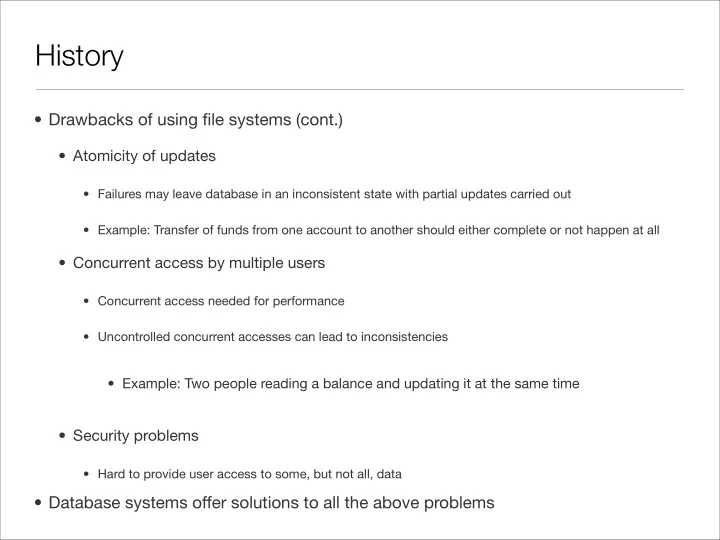

History • Drawbacks of using file systems (cont.) • Atomicity of updates • Failures may leave database in an inconsistent state with partial updates carried out • Example: Transfer of funds from one account to another should either complete or not happen at all • Concurrent access by multiple users • Concurrent access needed for performance • Uncontrolled concurrent accesses can lead to inconsistencies • Example: Two people reading a balance and updating it at the same time • Security problems • Hard to provide user access to some, but not all, data • Database systems offer solutions to all the above problems
Levels of Abstraction • Physical level : describes how a record is stored. • data structures used; byte level strorage • Logical level : describes the data stored in database, and the relationships among the data. • lowest level at which programmers and admin interact with database � type customer = record � � customer_id : string; � customer_name : string; � customer_street : string; � customer_city : integer; end ; • View level : application programs hide details of data types. Views can also hide information (such as an employee’s salary) for security purposes.
View of Data An architecture for a database system
Schemas and Instances • Similar to types and variables in programming languages • Schema – the logical structure of the database (at every level) ; rarely changes • E.g.: DB consists of information for set of customers, accounts, & their relationships • Analogous to type information of a variable in a program • Physical schema : database design at the physical level • Logical schema : database design at the logical level; most important • View schemas ( subschemas ) • Instance – the actual content of the database at a particular point in time • Analogous to the value of a variable • Physical Data Independence – the ability to modify the physical schema without changing the logical schema • Applications depend on the logical schema • interfaces between various levels should be well defined so that changes in some parts do not seriously influence others.
Data Models • A collection of conceptual tools for describing • Data • Data relationships • Data semantics • Data constraints • Relational model • tables; most widely used • Entity-Relationship data model (mainly for database design) • Object-based data models (Object-oriented and Object-relational) • Semistructured data model (XML) • Other older models: • Network model • Hierarchical model
Data Manipulation Language (DML) • Language for accessing and manipulating the data organized by the appropriate data model • Retrieval, insertion, deletion, modification • Query : statement in DML requesting information • DML also known as query language (technically incorrect) • SQL is the most widely used query language • Two classes of languages • Procedural – user specifies what data is required and how to get those data • Declarative (nonprocedural) – user specifies what data is required without specifying how to get those data • Abstraction: DML => physical level algorithms • ease of use
Data Definition Language (DDL) • For defining the database schema create table account ( • Example: � account-number char(10), balance integer) • Integrity constraints • Domain constraints (integer, character, date) • Referential integrity (referenced values across relations) • Assertions (always valid condition) • “every user with loan must have >$1000 balance” • Authorization (read, insert, modify, delete) • DDL compiler generates output: a set of tables stored in a data dictionary • Data dictionary (table) contains metadata (i.e., data about data) • Database schema • DD consuted before reading/modifying data
Recommend
More recommend